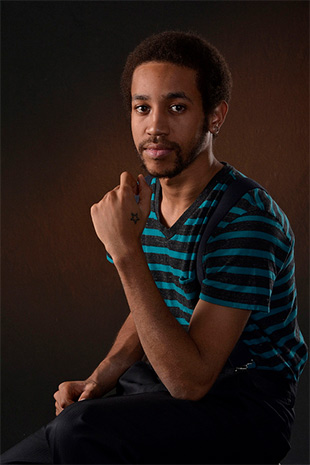In portrait photography, lighting ratios are comparisons of the main light in a photo to the lesser light that fills in the shadows. This main light is known as the key light, and the lesser light is called the fill light.
A lighting ratio can be expressed (K+F):F, where the main light is K+F because it includes both the key light and the fill light.
In other words, lighting ratios express the level of light on the brightest lit areas in a photograph compared to the least lit parts. This ratio is also known more simply as contrast.
Considering lighting ratios is important for portrait photography. The four most common lighting ratios for portrait photography are 1:1, 2:1, 3:1, and 4:1.

“Andrea Moore P3 Shot #1” captured by Andrea Moore using a 4:1 lighting ratio.
The lower ratios, 1:1 and 2:1, can be used for most photography needs. These ratios make the entire photograph easier to see, so they are often used for family photographs or headshots of small children and women. When the fill light is equal to the key light, or the ratio is 1:1, it is called flat lighting, because there is no contrast and few shadows in the photograph.
If you’re taking a photograph of a small child or a baby, it’s wise to use a 2:1 or 1:1 ratio, because small kids and babies can move unpredictably; it’s difficult to get a portrait in which the entire face is sufficiently lit. A stronger fill light ensures that you can take a photograph without too much shadow on the face, even if the subject won’t face the main light.
For portraits of women, 2:1 is the ratio that is commonly used. Lower ratios and lower contrast help to highlight women’s hair while leaving just enough shadow to show the features in her face. For this reason, and to make sure the background isn’t too dark, 2:1 is also used often for portraits of models.
A lighting ratio of 3:1 can be used if a 2:1 lighting ratio doesn’t include enough shadow or seems too bright. This ratio is a good choice for photos of men or any portrait used for professional or business purposes. For black and white photography of any kind, 3:1 is a good ratio choice, since 2:1 will usually seem noticeably bright , but a darker 4:1 ratio will have more black and darkly shaded areas.
As with the ratio 3:1, 4:1 works well for pictures of men. This ratio gives a more “dramatic” impression to a portrait. For general photos of men, or photographs intended to portray a person as a business professional, this is an ideal lighting ratio to use.

“Rob Knode Studio Prj4 Shot” captured by rknode1 with a 3:1 lighting ratio.
As the ratio of key light to fill light rises, the photograph appears more and more dramatic and the shadows in the picture become darker. For this reason, the most common lighting ratios for portrait photography are 1:1 through 5:1. But, while anything higher than 5:1 is generally not the best choice for photographs of faces, these higher ratios can be used for portraits which include more of a person’s body, or for side-shots of the face. In these kinds of pictures, you sometimes want to have more light on one side and to emphasize shadows.
Here is a helpful video tutorial on the subject:

Remember that choosing a lighting ratio is a highly subjective process. There is never a “best” ratio for any photograph. Photography is an art, and the choice of lighting ratio should be experimented with just like everything else.
Like This Article?
Don't Miss The Next One!
Join over 100,000 photographers of all experience levels who receive our free photography tips and articles to stay current:






Helpful article and video!